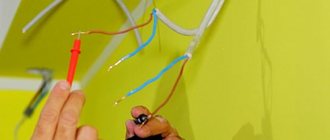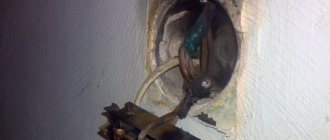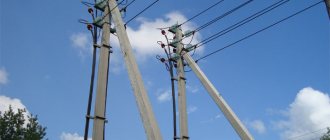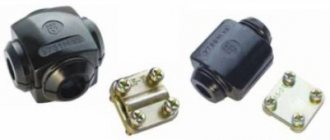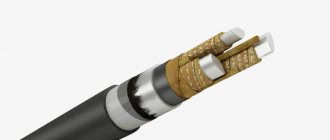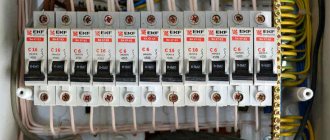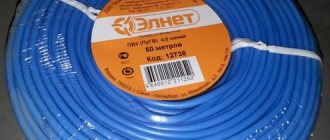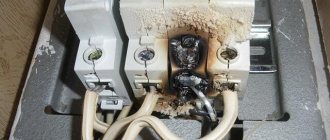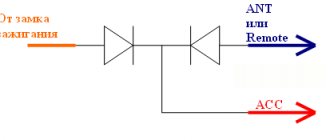When connecting a home network, it is first of all important to correctly calculate the phase contact. This need arises in the following situations:
- When connecting switches, this switching device must break the phase wire. If it is installed on the neutral conductor, the device will perform its functions. But in this case, when the device is turned off, the lamp socket will be energized, which is not safe when replacing the lighting element.
- When installing automatic machines, most often in everyday life, single-contact circuit breakers are used that open only the phase. Zero remains permanently closed. If the machine is installed on the neutral wire, the network will remain energized after the device is turned off, as a result of which it will not perform its intended functions.
To avoid errors, it is important for the consumer to correctly determine which wire is phase.
Expert opinion
Viktor Pavlovich Strebizh, lighting and electrical expert
Any questions ask me, I will help!
If the multimeter reads 1V or more but less than the battery voltage, there is too much resistance on the ground side of the circuit. If there is something you don’t understand, write to me!
How to find wiring in a wall without a device with your own hands or using a multimeter
- By alternately touching two of the three contacts, the phase and neutral wires are determined. In this position the lamp will light up.
- Next, the position of one of the conductors changes.
- If the lamp goes out (at the same time, the circuit breaker, if available, may operate), it means that the phase contact is disconnected, and the neutral and ground contacts are connected.
- In the absence of a circuit breaker, the lamp may continue to burn in two positions of one of the contacts. This means that one of them is zero, the second is ground. To correctly identify them, it is necessary to disconnect the ground terminal on the input cable and repeat the connection of the test lamp to each of the contacts. The lamp will not light on the ground wire.
Cable testers
This class of devices allows you to check both the integrity of the cable and the correctness of its connection, which is very important for Internet provider networks. These can be simple devices that check crossover or complex devices on a PIC controller that have an ADC and a built-in multiplexer.
Multipurpose cable tester Pro'sKit MT-7051N on a microcontroller
Naturally, the cost of such devices does not encourage their household use.
Determination methods
There are the following methods for determining the identity of the supplied wires:
Determination using instruments
The presence of special devices allows the owner to accurately identify the phase contact, saving himself from unpleasant situations.
Using a multimeter
A multimeter is a device that allows you to measure the basic characteristics of a network. In addition to other functions, it will not be difficult to determine the phase contact. This can be done anywhere - in an outlet, box, distribution board, etc.
- set the regulator to the position that allows for measuring alternating voltage. In this case, the available range for the device is from 1 to 200 or up to 750 V. Since 220 V is supplied to the household consumer, you should select the second of the indicated positions (designation on the front panel ACV with the number 750);
- one probe is applied to the contact, the second is clamped with your fingers. The screen will display the voltage value, by the value of which it will not be difficult to determine the identity of this wire (from 0 to 15 V - zero, up to 230 - phase).
It is not necessary to pinch the second dipstick with your fingers. You can touch the wall near the outlet or a grounded contact.
Knowing the phase contact, it will not be difficult to distinguish the ground from the working zero. To do this, with the switch position indicated above, you need to place one probe on the phase wire, touching the other two in turn. On the ground, the voltage value displayed by the device will be higher.
Similar measurements can be performed with any household appliance. Even the cheapest models are quite suitable for these purposes. The accuracy of their measurement will be quite sufficient.
Indicator screwdriver
An indicator screwdriver does not allow you to measure the voltage value, but it signals the presence of a phase with a light signal from the indicator.
If the wire is phase, the indicator will light up. Otherwise there will be no signal. An indicator screwdriver is especially convenient when checking sockets, as it easily penetrates inside the switching device.
Sequence of phase determination using an indicator screwdriver
The operation of this device is possible thanks to the presence of the following components inside the housing:
This method is much simpler than using a multimeter. This device is also much cheaper. The disadvantage of its use is the likelihood of false triggering when reacting to induced currents. Also, using an indicator screwdriver you will not be able to distinguish zero from ground.
Determination without instruments
In some situations, you can do without electrical appliances. But such methods do not guarantee one hundred percent accuracy, since it is possible that the performers may make mistakes when performing installation work and applying voltage.
How to determine phase and zero without special equipment
The conductor through which voltage is supplied to consumers is called a phase. The conductor in whose conductor the voltage returns from the consumer to the power supply source is called the working zero. There may also be a third wire - a grounding wire, which is connected to the body of the electrical appliance if it is subject to mandatory grounding.
If it is necessary to determine which wire is energized, it is enough to touch each strand of the conductor in turn with a measuring device. The voltage value shows the phase wire.
To find a live conductor, the following measuring instruments can be used:
But what to do if it is not possible to use measuring instruments? Here are some ways that can help in this case.
Safety rules when making calls
Any electrical work, including diagnostics of conductors, requires compliance with all precautions and electrical safety rules. The main rules, the observance of which will save your life and health, are as follows:
What kind of lighting do you prefer?
Built-in Chandelier
- Always operate with power off. Post a sign that says “DO NOT TURN ON. PEOPLE WORK!” at a switch or machine;
- Do not touch exposed conductors with bare hands, use special clothing and special tools;
- Use power tools with sharp edges carefully: use gloves and do not damage the cord;
- At the end of the work, all faulty systems must be de-energized, and exposed wires must be properly insulated.
Take care of yourself and remember, if you doubt that you are capable of working with electrical networks, entrust this task to professionals.
Checking different types of electric motors using a multimeter
How to use a multimeter - measuring voltage, current and resistance
How to test a capacitor for functionality with a multimeter?
How to install an electric doorbell - step-by-step instructions
Determination of the cross-sectional area of a conductor by its diameter
Why does the plug, RCD or automatic circuit breaker knock out when turning on or during operation of the washing machine?
How to determine phase and zero: with an indicator screwdriver, a multimeter and by wire color
It should be noted that in this way the presence of a short circuit in adjacent conductors is also checked. The only difference is that one probe is connected to the first conductor, and the second probe to the second: if there is sound, there is a short circuit.
Expert opinion
Viktor Pavlovich Strebizh, lighting and electrical expert
Any questions ask me, I will help!
In domestic conditions, for single checks and in the absence of a multimeter, testing of conductors is carried out using homemade test lamps or when connecting a load. If there is something you don’t understand, write to me!
Multimeter: instructions for connecting wires
The measuring instruments are sold with red and black wires and probes. One end of them is connected to a multimeter, and the probe is used to test the circuit. The red probe is usually used for positive values, and the black one for negative values.
Although there are only 2 wires, there are more places to connect them, which can cause confusion. The wire connection method depends on the item being measured and the model, so please refer to the user manual for details.
Most multimeters are protected from high current by a fuse, which will melt and break the circuit. This will prevent the device from malfunctioning.
If you apply the probes to an element or section of the circuit, the digital display will show the result. The switch sets voltage, current or resistance, as well as measurement limits.
Expert opinion
Viktor Pavlovich Strebizh, lighting and electrical expert
Any questions ask me, I will help!
To ensure that they do not interfere with the operation and stylish interior of the car, they are tied and placed in special channels along the sides, ceiling and floor of the car, and covered on top with finishing panels, carpeting and upholstery. If there is something you don’t understand, write to me!
Advantages of hidden wiring
Hidden wiring involves laying electrical cables in grooves - special niches in the wall, which are walled up with plaster on top. This type of installation has gained popularity due to the following advantages:
- Pleasant appearance. All cables are hidden, you can glue wallpaper, various tiles and other decorative elements to the wall.
- Reliability in operation. Hidden wiring is protected from external influences. Pets and children cannot damage it. There is no risk of breaking the cable when rearranging furniture, connecting household devices to the network and other operations.
- High fire safety. In the event of a short circuit, fire of the cable insulation can be avoided. Without access to oxygen, the plastic shell will not ignite, but will only melt under a layer of plaster.
Method for checking the condition of electrical wiring - Checking electrical wiring in an apartment
- When making calls, it is most convenient to use special tips at the ends of the measuring wires, which are more commonly known as “crocodiles”. They will make the contact stable and free your hands when taking measurements.
- When testing, the circuit being tested must always be de-energized (even low-current batteries must be removed). If there are capacitors in the circuit, they must be discharged by short-circuiting. Otherwise, the device will simply burn out during work.
- Before checking the integrity of a long length of conductor when taking measurements, it is important not to touch its bare ends with your hands. This is due to the fact that the resulting readings may be incorrect.
Testing multi-core cables for the purpose of marking them
When marking multi-core cables, you can use the methods described above, but there are ways to significantly simplify this process.
Method 1 : use of special transformers that have several secondary winding taps. The connection diagram for such a device is shown in the figure.
Using a transformer for marking
As can be seen from the figure, the primary winding of such a transformer is connected to the power supply network, one end of the secondary winding is connected to the protective shield of the cable, and the remaining terminals are connected to its conductors. To mark the wires, it is necessary to measure the voltage between the screen and each wire.
Method 2 : Use a block of resistors with different values connected to the cable wires on one side, as shown in the figure.
Resistors connected to cable terminals
To identify the cable, it is enough to measure the resistance between it and the screen. If you want to make such a device with your own hands, then you should select resistors in increments of at least 1 kOhm to reduce the influence of wire resistance. Also, do not forget that the value of the resistors has a certain error, so first measure them with an ohmmeter.
When checking a multi-core telephone cable, installers often use a dialing headset, for example TMG 1. Actually, these are two telephone handsets, one of which is connected to a 4.5 V battery. Such a simple device allows you not only to check the cable, but also to coordinate your actions during installation and testing.
Calling with a telephone handset
How to connect multimeter wires
Many beginners, after purchasing, often have a question: where to insert the wires (to be precise, they are called probes ) of the multimeter and how to do it correctly.
Most multimeters have three wire connectors and two wires - black and red. The black is inserted into the socket labeled COM , the red wire into the socket where the symbols include the designation V.
The third socket is used to measure high currents and we don’t need it to measure voltage; in general, if necessary, the red wire is plugged into it, and the black one always remains in one socket.
Timing for replacement of electrical wiring
After the electrical wiring has reached the end of its service life, it needs to be completely replaced without testing or inspection. The timing of inspection, replacement or interval between major repairs is established by VSN 58-88(r) (departmental building codes) and is:
- for hidden indoor networks 40 years;
- for open 25 years;
- for main wiring between apartments and input and distribution devices 20 years;
- for production and technical premises and lighting of public places 10 years.
Checking the electrical wiring in an apartment or private house, despite its apparent complexity, if you have the necessary knowledge and a minimum set of tools, you can do it yourself, without inviting a qualified electrician.
Expert opinion
Viktor Pavlovich Strebizh, lighting and electrical expert
Any questions ask me, I will help!
In other words, when testing electrical circuits or electrical materials, we are shown the magnitude of the voltage drop, which is equal to the resistance of this section in Ohms. If there is something you don’t understand, write to me!
In what cases is wire testing carried out?
This question can be answered in a few words - if the current-carrying core breaks or the integrity of its insulation is compromised.
Let’s clarify this answer and consider typical situations:
- Let's say an outlet or switch stops working. After you have made sure that the problem is not in the connections (including the junction box) and not in the light bulb (lamp), it is advisable to ring the wires in this area. If the integrity of the wiring is compromised, the multimeter will signal this.
- Developing the first example, it can be noted that such situations are not uncommon during repair work (drilling holes) and short circuits due to dilapidated wiring and network overloads.
- An atypical, but quite effective use of multimeter testing is to determine the required conductors on large sections of wiring. This method is appropriate when the color marking of the wires does not allow you to accurately identify the desired conductor.
- Also, in everyday life, dialing allows you to determine the integrity of electrical appliances (lamp, iron, switch, fuse). And if you are well versed in electronics, then when soldering, repairing printed circuit boards and other devices, testing circuits is a mandatory step.
Multimeter for testing wires
What do you need to know about this device? Firstly, it is worth noting the price variety and availability. Even inexpensive multimeters can flawlessly cope with many tasks, including testing wires.
Let's take a closer look at a typical budget option. Let's get acquainted with the design, layout and determine its functionality.
As you can see, a typical device has a digital display, controls and sockets for connecting probes. Let's decipher the main modes of the multimeter:
- OFF – the device is turned off (some devices have a special button for this).
- ACV (may be designated V~) – measurement of alternating voltage.
- DCV (can be designated V...) – DC voltage measurement.
- ACA (may be designated A~) – measurement of alternating current.
- DCA (may be designated A...) – direct current measurement.
- Ω - resistance measurement.
- hFE – measurement of transistor parameters.
- ->Ι- – conductivity check (circuit continuity).
The sockets for connecting probes are marked as follows:
- COM(-) – common socket for connecting the black wire.
- VΩmA(+) – socket for connecting the red wire.
- 10A...MAX – socket for connecting the red wire when measuring direct current, the maximum value of which does not exceed 10 Amperes.
Within the framework of the issue under consideration, only two modes of the multimeter will be considered:
The presence of sound, which is not mandatory, complements the dialing mode and simplifies the verification process. You do not need to constantly be distracted and look at the device display. The presence or absence of a buzzer signal will give a clear indication of the integrity of the conductor being measured.
External structure and functions
Recently, specialists and radio amateurs mainly use electronic models of multimeters. This does not mean that switches are not used at all. They are indispensable when electronic devices simply do not work due to strong interference. But in most cases we are dealing with digital models.
There are different modifications of these measuring instruments with different measurement accuracy and different functionality. There are automatic multimeters in which the switch has only a few positions - they select the nature of the measurement (voltage, resistance, current) and the device selects the measurement limits itself. There are models that can be connected to a computer. They transfer measurement data directly to a computer, where they can be saved.
Automatic multimeters have only types of measurements on the scale
But most home craftsmen use inexpensive models of the middle class of accuracy (with a bit resolution of 3.5, which ensures an accuracy of 1%). These are common multimeters dt 830, 831, 832, 833. 834, etc. The last number shows the “freshness” of the modification. Later models have wider functionality, but for home use these new features are not critical. Working with all these models is not much different, so we will talk in general about the techniques and procedures.
Structure of an electronic multimeter
Before using a multimeter, let's study its structure. Electronic models have a small liquid crystal screen on which measurement results are displayed. Below the screen there is a range switch. It rotates around its axis. The part on which the red dot or arrow is marked indicates the current type and range of measurements. There are marks around the switch that indicate the type of measurements and their range.
General structure of the multimeter
Below on the case there are sockets for connecting probes. Depending on the model, there are two or three sockets; there are always two probes. One is positive (red), the second negative is black. The black probe is always connected to a connector labeled “COM” or COMMON or that is labeled “ground.” Red - into one of the free slots. If there are always two connectors, no problems arise; if there are three sockets, you need to read the instructions for which measurements to insert the “positive” probe into which socket. In most cases, the red probe is connected to the middle socket. This is how most measurements are carried out. The upper connector is necessary if you are measuring a current of up to 10 A (if more, then also in the middle socket).
Where to connect multimeter probes
There are tester models in which the sockets are located not on the right, but at the bottom (for example, the Resanta DT 181 multimeter or the Hama 00081700 EM393 in the photo). In this case, there is no difference in connection: black to the socket with the inscription “COM”, and red, depending on the situation - when measuring currents from 200 mA to 10 A - to the far right socket, in all other situations - to the middle one.
The sockets for connecting probes on multimeters can be located at the bottom
There are models with four connectors. In this case, there are two sockets for measuring current - one for microcurrents (less than 200 mA), the second for current strength from 200 mA to 10 A. Having understood what is in the device and why, you can begin to figure out how to use a multimeter.
Switch position
The measurement mode depends on the position of the switch. There is a dot at one of its ends, it is usually tinted white or red. This end indicates the current operating mode. In some models, the switch is made in the form of a truncated cone or has one pointed edge. This sharp edge is also a pointer. To make your work easier, you can apply bright paint to this pointing edge. This could be nail polish or some kind of abrasion-resistant paint.
Position of the measuring range switch on the multimeter
By turning this switch you change the operating mode of the device. If it stands vertically up, the device is turned off. In addition, there are the following provisions:
- V with a wavy line or ACV (to the right of the “off” position) - AC voltage measurement mode;
- A with a straight line—DC measurement;
- A with a wavy line - determination of alternating current (this mode is not available on all multimeters; it is not present in the photos above);
- V with a straight line or the inscription DCV (to the left of the off position) - for measuring DC voltage;
- Ω - resistance measurement.
There are also provisions for determining the gain of transistors and determining the polarity of diodes. There may be others, but their purpose must be found in the instructions for a specific device.
Using a hearing aid
Finding wires with a compass
Smartphones
Modern programs designed for all kinds of iPhones and other gadgets, although they claim that they can easily find metal objects and respond to magnetic fields, should still be perceived as expensive toys, and not devices capable of finding hidden wiring. And you should under no circumstances trust them.
The exception is an additional device scanner for a smartphone from walabot. You can get acquainted with it in the article Finding wiring with a smartphone - Walabot DIY scanner. To summarize, we need to remind you once again that all of the above methods have a very large error in detecting hidden wiring (often up to several tens of centimeters). And you shouldn't trust them.
To accurately determine where the wire lies under the plaster, it is better to use inexpensive devices (Woodpecker, detector MS 158), which are discussed in the article Device for identifying hidden wiring, but professionals can use a high-quality tool, the Hilti PS 38 Multidetector.
You can view and compare current prices for detectors from different manufacturers here.
How to check the current in wires with a multimeter
Qualified electricians, when performing wiring in distribution boxes, mark the phase wire, identifying it with a cardboard tag suspended on a thread. If such markings are present, the phase can always be determined.
Expert opinion
Viktor Pavlovich Strebizh, lighting and electrical expert
Any questions ask me, I will help!
For an owner who does not have extensive knowledge of electrical engineering, it is important to listen to the following recommendations from experienced electricians. If there is something you don’t understand, write to me!
How to prepare for testing car wires
Before checking the wiring in your car with a multimeter, you will need to prepare a regular digital household multimeter, test leads, a long wire and alligator clips. You will also need to have a vehicle repair manual and a wiring diagram.
Checking relays and fuses
According to the Auto Repair Manual, it is determined which fuse or relay is associated with the non-working equipment. If there are several non-working components, the common points in the circuit are determined from the connection diagram. This will significantly narrow down the troubleshooting area.
- Turn off the engine.
- Open the cover of the fuse compartment, which is usually located under the steering wheel or under the hood of the car, and is indicated by a small electrical symbol.
- There is a guide on the fuse box cover to help you determine the function of each and locate it.
- Using the small pliers supplied with the block, release the fuse being tested without any effort.
- If, upon external inspection, a black spot is noticed on the numbers or a broken thread, then the fuse has blown and must be replaced.
For a more accurate check, use a multimeter in dial mode. If the fuse does not ring, it is faulty. Replace the blown fuse with a new one with similar characteristics.
Visual inspection of wiring
Expert opinion
Viktor Pavlovich Strebizh, lighting and electrical expert
Any questions ask me, I will help!
If the wire core is damaged and one of its ends does not have an electrical connection with the other, then the multimeter readings will not change, 1 will be displayed and there will be no sound signal. If there is something you don’t understand, write to me!
Checking the wire for a break with a multimeter
Checking the integrity of the car wires must be carried out in compliance with electrical safety rules. Otherwise, the performer may receive electric shock. He must also understand the basic functioning of electrical equipment in order to perform the test correctly.
Important! If a car owner has doubts about his ability to work safely in electrical networks, then it is better to use the services of an electrician.
Therefore, for this test to be successful, you will need a multimeter, a wrench, and also a flashlight. Before performing the test, make sure that the power supply to the wire is turned off.
Setting up the multimeter
Resistance measurements are carried out using special probe wires: black is inserted into the COM connector, and red into the AV connector. Before starting work, make sure that the probes are correctly installed and secured.
Continuity testing
If there is no voltage at the fuse, and the fuse itself is working, then you will need to check the section of the circuit between the fuse holder connection and the battery. For example, there may be a poor connection to the battery in this part of the circuit.
When checking electrical or electronic components in a car, use a 10 megohm digital multimeter to prevent damage to the car's computer and other electrical devices.
- Select the circuit to be tested.
- Turn the ignition key to the “On” position and start the engine at idle speed.
- Connect the negative black lead of the meter to ground, and the positive red lead to the positive load side of the circuit under test.
- If the multimeter scale reads 0 V, move the red meter lead to the output side of the switch or relay control device. If 10.5 V now appears on the screen, then there is a gap between the load and the control device. If above 10.5 V, then move the red meter lead to the grounded side of the load.
- If the multimeter reads 1V or more but less than the battery voltage, there is too much resistance on the ground side of the circuit. This could be a corroded or loose connection, or a damaged wire that is preventing current from flowing properly.
- If the multimeter shows battery voltage, it means there is an open circuit on the ground side of the circuit.
Attention! In order to fix this, make sure that the grounding line is intact and not subject to corrosion. If necessary, install a jumper to create a reliable good grounding in order to determine the operability of the circuit with an intact grounding line.
Useful tips Connection diagrams Principles of operation of devices Main concepts Meters from Energomer Precautions Incandescent lamps Video instructions for the master Testing with a multimeter
Measurements
Using an electronic tester is convenient because you don’t have to look for the right scale, count divisions, and determine the readings. They will be displayed on the screen accurate to two decimal places. If the measured value has polarity, then a minus sign will also be displayed. If there is no minus sign, the measurement value is positive.
How to measure resistance with a multimeter
To measure resistance, move the switch to the area indicated by the letter Ω. Select any of the ranges. We apply one probe to one input, the second to the other. The numbers that appear on the display are the resistance of the element you are measuring.
How to use a multimeter to measure resistance
Sometimes what appears on the screen is not numbers. If 0 “jumps out,” then you need to change the measurement range to a smaller one. If the words “ol” or “over” are highlighted, the value is “1”, the range is too small and needs to be increased. That's all the tricks for measuring resistance with a multimeter.
How to measure current
To select a measurement mode, you must first determine whether the current is direct or alternating. There may be problems with measuring AC parameters - this mode is not available on all models. But the procedure is the same regardless of the type of current - only the position of the switch changes.
Read also: A transformer is a device designed for
D.C
So, having decided on the type of current, we set the switch. Next, you need to decide which socket to connect the red probe to. If you don’t even know approximately what values to expect, so as not to accidentally burn the device, it is better to first install the probe in the upper (leftmost in other models) socket, which is labeled “10 A”. If the readings are small - less than 200 mA, move the probe to the middle position.
The situation is exactly the same with the choice of measurement range: first set the maximum range, if it turns out to be too large, switch to the next smaller one. Do this until you see the readings.
How to connect a multimeter to measure DC current
To measure current, the device must be connected to an open circuit. The connection diagram is shown in the figure. In this case, it is important to install the red probe on the “+” of the power source and touch the black probe to the next element of the circuit. When measuring, do not forget that there is power, work carefully. Do not touch the bare ends of the probe or circuit components with your hands.
Alternating current
You can try the AC current measurement mode on any load connected to a household electrical outlet and thus determine the current consumed. Since in this mode the device must be connected to an open circuit, difficulties may arise with this. You can make a special cord for measurements, as in the photo below. There is a plug at one end of the cord, a socket at the other, cut one of the wires, attach two WAGO connectors to the ends. They are good because they also allow you to clamp the probes. After the measuring circuit is assembled, we proceed to measurements.
Measuring AC current with an electronic multimeter
Move the switch to the “alternating current” position, select the measurement limit. Please note that exceeding the limits may damage the device. At best, the fuse will burn out, at worst, the “filling” will be damaged. Therefore, we act according to the scheme proposed above: first we set the maximum limit, then gradually reduce it. (don’t forget about rearranging the probes in the sockets).
AC current measurement circuit
Now everything is ready. First, connect the load to the outlet. Maybe a table lamp. We insert the plug into the network. Numbers appear on the screen. This will be the current consumed by the lamp. In the same way, you can measure the current consumption for any device.
Voltage measurement
The voltage can also be variable or constant; accordingly, select the required position. The approach to choosing a range is the same: if you don’t know what to expect, set it to the maximum, gradually switching to a smaller scale. Do not forget to check whether the probes are connected correctly and into the correct sockets.
In this case, the measuring device is connected in parallel. For example, you can measure the voltage of a battery or a regular battery. We set the switch to the DC voltage measurement mode position, since we know the expected value, we select the appropriate scale. Next, use the probes to touch the battery on both sides. The numbers on the screen will be the voltage that this battery produces.
How to use a multimeter to measure voltage
How to use a multimeter to measure AC voltage? Yes, exactly the same. Just choose the right measurement limit.
Testing wires using a multimeter
This operation allows you to check the integrity of the wires. On the scale we find a continuity sign - a schematic representation of the sound (look at the photo, but there is a double mode, or maybe there is only a continuity sign). This image was chosen because if the wire is intact, the device makes a sound.
Dial mode on the multimeter measurement scale
We put the switch in the desired position, the probes are connected as usual - into the lower and middle sockets. We touch one edge of the conductor with one probe, and the other with the other. If we hear a sound, the wire is intact. In general, as you can see, using a multimeter is not difficult. Everything is easy to remember.
If the task is to check the electrical circuit for breaks (leaks), then you need to familiarize yourself with how to test the wires with a multimeter. A specialized measuring device is indispensable when testing wiring. And even if you are not a professional electrician, once you understand the basic rules for safe use of a multimeter, you can easily identify problem areas in your home electrical network.
